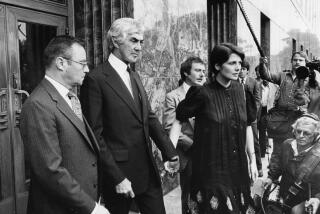Enron and Ivan Boesky: Symbols of Their Eras
With every financial market boom, then bust, one person or company often emerges as the symbol of all that went terribly wrong.
In the late 1980s and early ‘90s that symbol was Ivan Boesky, the stock trader who agreed to pay $100 million to settle insider-trading charges, and then helped implicate junk bond king Michael Milken and others in a far wider federal investigation of dirty dealings on Wall Street.
Today, there is a long list candidates from which to select the enduring symbol of the late 1990s economic and market boom and the bust that has followed. But they are mostly general themes rather than individual names: dot-com companies in aggregate, for example; manipulated initial public share offerings; brokerage analysts who never met a stock they didn’t like; accounting firms that never met a “pro forma” earnings statement they couldn’t certify.
By last week, however, one individual name was rapidly moving up the candidate list: Enron Corp.
The former energy-trading giant, which on Dec. 2 became the largest bankruptcy in U.S. history, may for future generations summarize in two syllables all of the excesses that marked the late-’90s boom and helped precipitate the subsequent bust.
Consider: Enron, like dot-com companies, was a “new paradigm” business that argued (successfully, for a while) that its stock deserved a premium valuation because there wasn’t much brick and mortar to support it, but rather intellectual assets, financial savvy and the seeming certainty that the firm’s vision of the energy business’ future was the correct vision.
Enron also had virtually every analyst on Wall Street in its breast pocket, in part because of a take-no-prisoners approach to those who challenged it. During one investor conference call last spring, a money manager who dared to ask then-Enron Chief Executive Jeffrey Skilling for an updated company balance sheet was called an obscenity by Skilling.
As analysts and investors found out much too late, Enron had plenty to hide: By October, the company began to reveal the extent of losses it had racked up doing business with largely hidden partnerships run by Enron executives. The company’s financial statements were rewritten back to 1997, sharply reducing the earnings investors had believed were real.
As the company careened toward bankruptcy, and a once $90 stock became worth pennies, a key question was, “Where were the auditors?” Why didn’t the company’s independent accountants raise issues with Enron’s inflated financial results?
Last week the auditing firm, Andersen, detonated a bomb of its own, announcing that its employees had destroyed a “significant” number of documents related to Enron audits.
By Friday, it still wasn’t clear whether the documents had been destroyed intentionally or by accident. But the outcome may be the same either way: the demise of Andersen itself, the fifth-largest U.S. accounting firm.
Thus, the similarities between the Ivan Boesky saga and the Enron story continue to grow. Both reeked of astounding hubris, self-dealing and greed.
Boesky, it was argued, ripped off small investors by trading takeover stocks with inside knowledge, and by manipulating securities prices to suit his desires. The same was said of Milken and his brokerage, Drexel Burnham Lambert. Boesky’s testimony was key to the eventual imprisonment of Milken and the bankruptcy of Drexel.
But it was impossible to measure exactly how much small investors were harmed by the self-dealing of Boesky and Milken. In some cases, investors who bet on the same takeover stocks that Boesky played may have profited, thanks to him. (Some defenders of Boesky at the time argued that his crimes were essentially victimless, and that he was a piker among Wall Street crooks.)
As for Milken, whose enormous power to manipulate the corporate junk bond market clearly had corrupted him, his downfall helped at least temporarily to crush the value of many junk bonds in 1990, ruining some investors’ fortunes.
But Milken’s underwriting skills also helped to build up many legitimate companies in the 1980s (among them: phone giant MCI, now part of WorldCom, and Ted Turner’s Turner Broadcasting, now part of AOL Time Warner), creating thousands of jobs that didn’t disappear when he went off to prison. And the junk bond market quickly recovered in the early 1990s, and today is larger than ever and a critical source of financing for many companies.
Enron’s collapse, by contrast, took with it the retirement savings of thousands of employees, and punched serious, and likely irreparable, holes in the portfolios of many institutional and individual investors. Many analysts believe it is highly unlikely that Enron’s common shareholders will collect a cent in the bankruptcy.
(The stock didn’t trade Friday, and the New York Stock Exchange said it will continue to suspend trading pending more details on Enron’s future. The shares closed at 67 cents on Thursday.)
Whether Enron’s business concept as an energy trader will prove to be a lasting legacy for its industry remains to be seen.
For now, the company’s name is certain only to remind future generations of the biggest scandals of the last bull market: investors’ blind faith in the promises of arrogant corporate managers; Wall Street analysts’ (and, perhaps, the financial media’s) inability or unwillingness to question conventional wisdom; and independent auditors’ failures in the process of discovery and disclosure of companies’ true financial positions.
Tom Petruno can be reached at [email protected]. For recent columns on the Web, go to: www.latimes.com/petruno.
More to Read
Inside the business of entertainment
The Wide Shot brings you news, analysis and insights on everything from streaming wars to production — and what it all means for the future.
You may occasionally receive promotional content from the Los Angeles Times.










